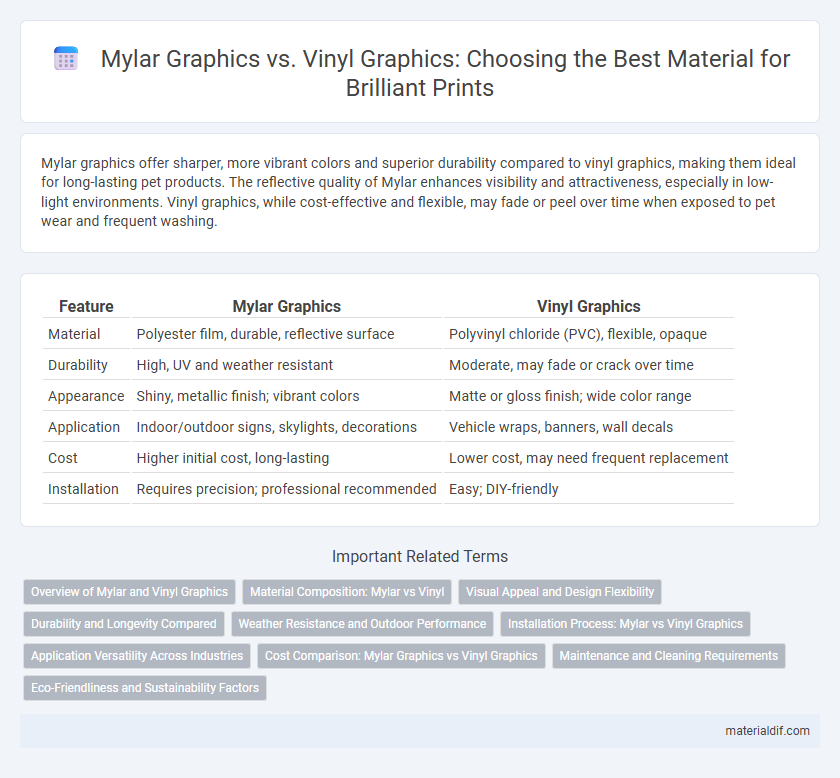Mylar graphics offer sharper, more vibrant colors and superior durability compared to vinyl graphics, making them ideal for long-lasting pet products. The reflective quality of Mylar enhances visibility and attractiveness, especially in low-light environments. Vinyl graphics, while cost-effective and flexible, may fade or peel over time when exposed to pet wear and frequent washing.
Table of Comparison
| Feature | Mylar Graphics | Vinyl Graphics |
|---|---|---|
| Material | Polyester film, durable, reflective surface | Polyvinyl chloride (PVC), flexible, opaque |
| Durability | High, UV and weather resistant | Moderate, may fade or crack over time |
| Appearance | Shiny, metallic finish; vibrant colors | Matte or gloss finish; wide color range |
| Application | Indoor/outdoor signs, skylights, decorations | Vehicle wraps, banners, wall decals |
| Cost | Higher initial cost, long-lasting | Lower cost, may need frequent replacement |
| Installation | Requires precision; professional recommended | Easy; DIY-friendly |
Overview of Mylar and Vinyl Graphics
Mylar graphics utilize a durable polyester film known for its high tensile strength, clarity, and resistance to moisture and chemicals, making them ideal for long-lasting outdoor signage and decorative applications. Vinyl graphics, made from flexible polyvinyl chloride (PVC), offer excellent adhesion to various surfaces and are widely used for vehicle wraps, wall decals, and banners due to their vibrant color reproduction and weather resistance. Both materials excel in different scenarios: Mylar provides superior dimensional stability and surface smoothness, while vinyl offers versatility in texture and application methods.
Material Composition: Mylar vs Vinyl
Mylar graphics are made from polyethylene terephthalate (PET), a durable polyester film known for its strength, flexibility, and resistance to moisture and chemicals. In contrast, vinyl graphics are composed primarily of polyvinyl chloride (PVC), which offers high durability and weather resistance but may release harmful chemicals during production and degradation. The choice between Mylar and vinyl materials influences graphic longevity, environmental impact, and performance in various applications.
Visual Appeal and Design Flexibility
Mylar graphics offer superior visual appeal with their high gloss finish and vibrant color retention, making designs stand out in both indoor and outdoor settings. The material's flexibility allows intricate, detailed designs and precise cuts, surpassing the often thicker, less refined vinyl graphics. Vinyl graphics, while durable and cost-effective, typically lack the same crispness and brilliance achievable with Mylar, limiting design versatility.
Durability and Longevity Compared
Mylar graphics offer superior durability and longevity compared to vinyl graphics due to their resistance to UV rays, moisture, and temperature fluctuations, making them ideal for long-term outdoor use. Unlike vinyl, Mylar maintains its color vibrancy and structural integrity over extended periods without cracking or fading. This enhanced resilience makes Mylar graphics a cost-effective choice for signage and displays exposed to harsh environmental conditions.
Weather Resistance and Outdoor Performance
Mylar graphics exhibit superior weather resistance compared to vinyl graphics due to their polyester film composition, which offers exceptional durability against UV rays, moisture, and temperature fluctuations. Outdoor performance is enhanced with Mylar graphics as they maintain color integrity and structural stability over extended exposure to harsh environmental conditions. Vinyl graphics, while cost-effective, tend to degrade faster, showing signs of fading and cracking when subjected to prolonged sunlight and extreme weather.
Installation Process: Mylar vs Vinyl Graphics
Mylar graphics offer a smoother installation process due to their thinner, more flexible material, allowing for easier application on curved surfaces without bubbles or wrinkles. Vinyl graphics, though thicker and more durable, often require more skill and time to properly align and prevent air pockets during installation. Both materials benefit from professional application, but Mylar's lightweight properties provide a distinct advantage in complex or detailed installations.
Application Versatility Across Industries
Mylar graphics offer superior application versatility compared to vinyl graphics, excelling in industries such as aerospace, automotive, and electronics due to their enhanced durability, heat resistance, and clarity. Their ability to conform to complex surfaces and maintain high-resolution detail makes them ideal for technical labeling and branding in challenging environments. Vinyl graphics remain popular for outdoor signage and promotional materials but often fall short in extreme conditions where Mylar's advanced properties provide a significant advantage.
Cost Comparison: Mylar Graphics vs Vinyl Graphics
Mylar graphics typically cost more upfront than vinyl graphics due to the specialized reflective material and enhanced durability. Vinyl graphics offer a budget-friendly option with lower initial expenses but may require more frequent replacement, increasing long-term costs. Comparing total lifecycle expenses, Mylar's longevity can make it more cost-effective despite higher initial investment.
Maintenance and Cleaning Requirements
Mylar graphics require gentle cleaning with mild soap and water to preserve their reflective surface and prevent damage to the metallic finish. Vinyl graphics offer more flexibility in cleaning options, as they tolerate stronger detergents and scrubbing without losing adhesion or color vibrancy. Both materials benefit from regular maintenance, but Mylar's delicate nature demands more cautious handling to ensure longevity and appearance.
Eco-Friendliness and Sustainability Factors
Mylar graphics offer superior eco-friendliness compared to vinyl graphics due to their recyclability and reduced environmental impact during production. Unlike vinyl, which is derived from PVC and releases harmful chemicals during manufacturing and disposal, Mylar is a polyester film that can be recycled multiple times, reducing landfill waste. Sustainable applications favor Mylar for its durability and lower carbon footprint, making it a preferred choice in environmentally conscious graphic design.
Mylar Graphics vs Vinyl Graphics Infographic

 materialdif.com
materialdif.com